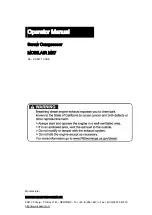
HPS Rotary Screw Compressor Units
070.700-IOM (MAR 21)
Page 18
Installation
Notice
When in doubt contact the factory or use threaded
metallic or threaded PVC coated metallic conduit.
Wiring practices
Do not mix wires of different voltages in the same conduit.
An example of this would be the installation of a screw
compressor package where the motor voltage is 480 V
and the electronic control panel power is 120 V. The 480
V circuit must be run from the motor starter to the motor
in its own conduit. The 120 V circuit must be run from the
motor starter control transformer to the electronic control
panel in its own separate conduit. If the two circuits are
run in the same conduit, transients on the 480 V circuit
are induced onto the 120 V circuit causing functional prob
-
lems with the electronic control panel. Metallic dividers
must be used in wire way systems (conduit trays) to sepa-
rate unlike voltages. The same rule applies for
120 V wires and 220 V wires.
Note:
Never run low voltage wires for DC analog devices or
serial communications in the same conduit as any AC
wiring which include 120 V wires. See the following
Figure.
Figure 23: Wiring example
Never run any wires through an electronic control panel
that do not relate to the function of the panel.
Never
use electronic control panels as a junction box. These
wires may be carrying large transients that interfere with
the operation of the control panel.
An extreme example
of this would be to run 480 V from the starter through
the electronic control panel to an oil pump motor.
When running conduit to the electronic control panel, use
the access holes (knockouts) provided by the manufac-
turer. These holes are strategically placed so that the field
wiring does not interfere with the electronics in the panel.
Never allow field wiring to come in close proximity with
the controller boards because this almost always causes
problems.
Do not drill into an electronic control panel to locate con-
duit connections. You are probably not entering the panel
where the manufacturer would like you to because most
manufacturer's recommend or provide prepunched conduit
connections. You may also be negating the NEMA rating of
the enclosure.
Drilling can cause metal filings to land on the electronics
and create a short circuit when powered is applied. If you
must drill the panel, take the following precautions:
•
First, call the panel manufacturer before drilling into the
panel to be sure you are entering the panel at the right
place.
•
Take measures to avoid ESD (electrostatic discharge) to
the electronics as you prep the inside of the Electronic
control panel. This can be done by employing an anti
-
static wrist band and mat connected to ground.
• Cover the electronics with plastic and secure it with
masking or electrical tape.
•
Place masking tape or duct tape on the inside of the
panel where you are drilling, to catch most of the fil
-
ings.
•
Clean all of the remaining filings from the panel before
removing the protective plastic.
When routing conduit to the top of an electronic control
panel, condensation must be taken into consideration.
Water can condense in the conduit and run into the panel
causing catastrophic failure. Route the conduit to the
sides or bottom of the panel and use a conduit drain. If
the conduit must be routed to the top of the panel, use a
sealable conduit fitting which is poured with a sealer after
the wires have been pulled, terminated, and the control
functions have been checked. A conduit entering the top
of the enclosure must have a NEMA-4 hub type fitting
between the conduit and the enclosure so that if water
gets on top of the enclosure it cannot run in between the
conduit and the enclosure. This is extremely important in
outdoor applications.
Notice
It is simply never good practice to enter through the
top of an electronic control panel or starter panel
that does not already have knockouts provided. If
knockouts are not provided for this purpose, do not
enter through the top of the panel. This may void
warranty.
Never add relays, starters, timers, or transformers,
for example, inside an electronic control panel with-
out first contacting the manufacturer.
Contact arcing
and EMI emitted from these devices can interfere with
the electronics. Relays and timers are routinely added to
electronic control panels by the manufacturer, because
the manufacturer knows the acceptable device types and
correct placement in the panel that keeps interference to
a minimum. If you need to add these devices, contact the
manufacturer for the correct device types and placement.
Never run refrigerant tubing inside an electronic control
panel.
If the refrigerant is ammonia, a leak totally destroys
the electronics.
















































